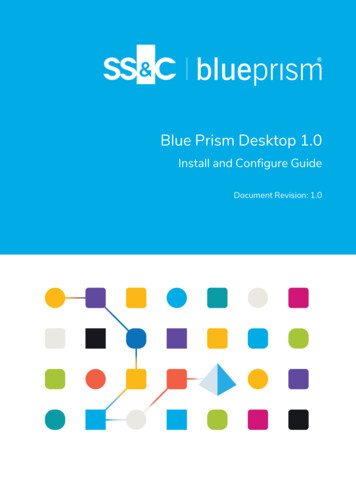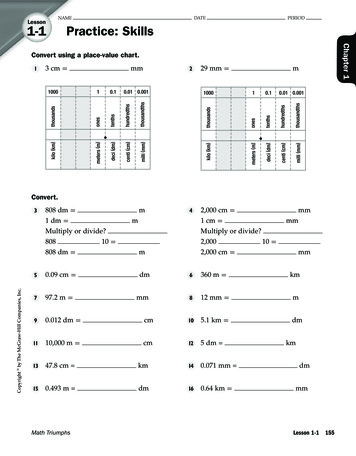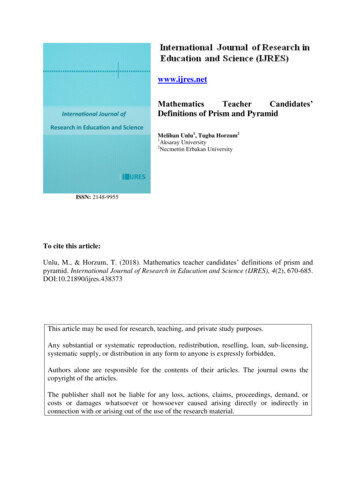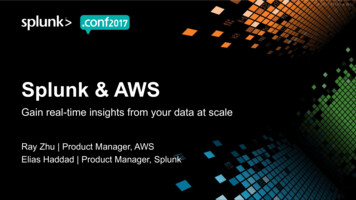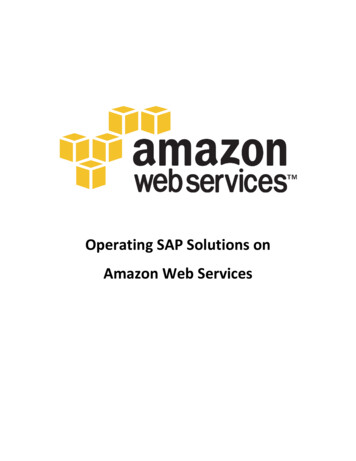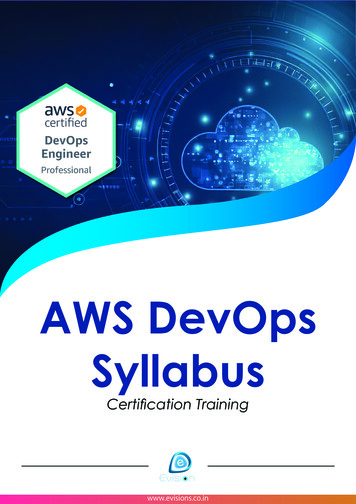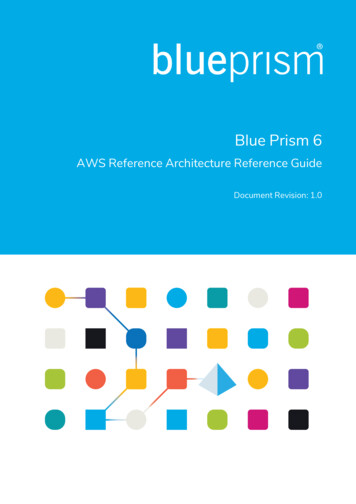
Transcription
Blue Prism 6AWS Reference Architecture Reference GuideDocument Revision: 1.0
Blue Prism 6 AWS Reference Architecture Reference GuideTrademarks and CopyrightTrademarks and CopyrightThe information contained in this document is the proprietary and confidential information of Blue PrismLimited and should not be disclosed to a third-party without the written consent of an authorized BluePrism representative. No part of this document may be reproduced or transmitted in any form or by anymeans, electronic or mechanical, including photocopying without the written permission of Blue PrismLimited. Blue Prism Limited, 2001 – 2021 “Blue Prism”, the “Blue Prism” logo and Prism device are either trademarks or registered trademarks ofBlue Prism Limited and its affiliates. All Rights Reserved.All trademarks are hereby acknowledged and are used to the benefit of their respective owners.Blue Prism is not responsible for the content of external websites referenced by this document.Blue Prism Limited, 2 Cinnamon Park, Crab Lane, Warrington, WA2 0XP, United Kingdom.Registered in England: Reg. No. 4260035. Tel: 44 370 879 3000. Web: www.blueprism.comCommercial in ConfidencePage 2
Blue Prism 6 AWS Reference Architecture Reference GuideContentsTrademarks and CopyrightContents23IntroductionIntended Audience44AWS Services and Key ConceptsAWS ServicesAWS SQL Server RDS vs SQL Server on EC2AWS Resource Configuration and Costing5556Blue Prism AWS Reference ArchitecturesSmall non-critical or POC Environment using SQL PAASSmall to Medium Scale Deployment using SQL PAAS with HADRMedium to Large Scale Deployment Using SQL Clustering78911Supporting Architecture PatternsAuthentication1212Other AWS CapabilitiesAWS WorkspacesAWS Elastic Load Balancers151515Key Design ConsiderationsKey DesignAWSSQL HighConsiderationsAvailability and FailoverKey design considerationsActive DirectoryExtendingOn-Premisesusing sManagedto the(MicrosoftAWSAD onCloudADAWSEnterprise(Single ADEdition)Forest)810111314Commercial in ConfidencePage 3 of 15
Blue Prism 6 AWS Reference Architecture Reference GuideIntroductionIntroductionThe document provides an overview of the key considerations for an AWS based deployment of BluePrism, along with reference architectures for the commonly requested patterns for a Cloud baseddeployment. The objective of this document is to explain the key considerations for deployment on AWS.A basic understanding of the AWS architecture is expected. The reference architectures contained withinthis document are based upon generalized assumptions and AWS design best practices and ReferenceArchitectures. The architecture may need to be modified to suit a client deployment.Intended AudienceThis information is intended for use by system architects and designers who are seeking to gain anunderstanding of the options and considerations for deploying a Blue Prism environment in the MicrosoftAWS Cloud.Commercial in ConfidencePage 4 of 15
Blue Prism 6 AWS Reference Architecture Reference GuideAWS Services and Key ConceptsAWS Services and Key ConceptsThe following sections outline some of the relevant services and concepts that are key in designing anAWS based Blue Prism deployment.AWS ServicesThe Blue Prism architecture uses several key AWS services and concepts. These are outlined below.Refer to the AWS documentation in the links for further information. Virtual Private Cloud – Amazon Virtual Private Cloud (Amazon VPC) lets you provision a logicallyisolated section of the Amazon Web Services (AWS) cloud where you can launch AWS resourcesin a virtual network that you define. You have complete control over your virtual networkingenvironment, including selection of your own IP address range, creation of subnets, andconfiguration of route tables and network gateways. Regions and Availability Zones - Amazon EC2 is hosted in multiple locations world-wide. Theselocations are composed of regions and Availability Zones. Each region is a separate geographicarea. Each region has multiple, isolated locations known as Availability Zones. Amazon EC2provides you the ability to place resources, such as instances, and data in multiple locations.Resources aren't replicated across regions unless you do so specifically. AWS Directory Service - AWS Directory Service provides multiple ways to set up and run AmazonCloud Directory and Microsoft AD with other AWS services. AWS Directory Service for MicrosoftActive Directory (Enterprise Edition), also known as Microsoft AD, enables your directory-awareworkloads and AWS resources to use a managed Active Directory and enables Blue Prism to beintegrated into a domain. Security Group - A security group acts as a virtual firewall that controls the traffic for one or moreinstances. When you launch an instance, you associate one or more security groups with theinstance. You add rules to each security group that allow traffic to or from its associated instances.You can modify the rules for a security group at any time; the new rules are automatically applied toall instances that are associated with the security group.AWS SQL Server RDS vs SQL Server on EC2The selection of an SQL Platform as a Service (PAAS) based architecture is not just dependent on thesizing. The limitations (and advantages) of using a PAAS platform should also be understood. These aredetailed fully here, however the main considerations in context of a Blue Prism deployment will be: Size – Primarily limited by the current maximum size of 4TB, as Blue Prism generates a highvolume of database logging. Speed of deployment – Using PAAS will enable an environment to be initiated more quickly Management and Control – Managed platform vs full control over configuration and security Cost – Using a PAAS solution may be cheaper overall (if correctly sized) Features – Access to some features is limited in AWS RDS vs a full Infrastructure as a Service(IAAS) installation.Commercial in ConfidencePage 5 of 15
Blue Prism 6 AWS Reference Architecture Reference GuideAWS Services and Key ConceptsAWS Resource Configuration and CostingMost of a Blue Prism deployment on AWS is made up of EC2 instances running as Blue Prism robots. Fora successful, basic deployment the following AWS resources should be considered – this list is neitherexhaustive nor definitive for a deployment: VPC – located in an appropriate region. EC2 instance(s) with SQL Server installed or an AWS RDS implementation. EC2 instance(s) with Blue Prism installed and configured acting as Blue Prism Application Servers. EC2 instance(s) with Blue Prism installed and configured acting as Blue Prism Clients. EC2 instances with Blue Prism installed and configured acting as Blue Prism Robots.The resources listed above should be sized appropriately according to the deployment, customerrequirements and Blue Prism best practices.To ensure high availability of a Blue Prism deployment the resources listed should be spread acrossavailability zones within the AWS region. Further information on this is contained within this guide.Total Cost of Ownership (TCO) for Blue Prism infrastructure deployed on AWS can be calculated usingthe AWS pricing calculator. The cost displayed in the calculator is for the infrastructure only, for a trueTCO value Blue Prism license costs should be included.Commercial in ConfidencePage 6 of 15
Blue Prism 6 AWS Reference Architecture Reference GuideBlue Prism AWS Reference ArchitecturesBlue Prism AWS Reference ArchitecturesThe following sections outline the core reference architectures for the expected deployment models forBlue Prism on the AWS cloud. These are supplemented by peripheral design considerations andscenarios, such as integration with Single Sign-On (SSO) in Supporting Architecture Patterns.General Assumptions and Limitations: A connection is in place between the Blue Prism network and any external networks where theautomated applications reside. This may be via a VPN, internal Vnet Peering (for cloud hostedapplications) or AWS Direct Connect If the target applications are expected to be on the other end of the VPN / AWS Direct connect link,careful consideration must be given to routing and bandwidth across this connection Blue Prism clients and runtimes will need to have all necessary software installed to facilitate theautomation of remote applications Beyond high level recommendations regarding segregation of components, network design isoutside the scope of this document. The Authentication components are not shown within these sections. See Supporting ArchitecturePatterns for considerations. Access to an AWS account has been configured and suitable Windows licensing for constituentresources have been sourced Management of deployment keys, secrets and certificates are not included in this document asAWS account management is the responsibility of the deploying party. All resource specifications should be defined based on the recommendations in the InfrastructureReference Guide, which is available from the Blue Prism Portal.Commercial in ConfidencePage 7 of 15
Blue Prism 6 AWS Reference Architecture Reference GuideBlue Prism AWS Reference ArchitecturesSmall non-critical or POC Environment using SQL PAASThis pattern makes use of the AWS RDS SQL Server Database Platform as a Service (PAAS) offeringand is only suitable for small non-critical environments.Key Design Considerations SQL Server Express may be used for POC environments to minimize cost. Other editions should beselected for anything but the most basic of environments. A single Application server is depicted here, however this may be increased to 2 or more asrequiredCommercial in ConfidencePage 8 of 15
Blue Prism 6 AWS Reference Architecture Reference GuideBlue Prism AWS Reference ArchitecturesSmall to Medium Scale Deployment using SQL PAAS with HADRThis pattern makes use of the AWS RDS SQL server Database Platform as a service (PAAS) offering andis designed to support HADR.Commercial in ConfidencePage 9 of 15
Blue Prism 6 AWS Reference Architecture Reference GuideBlue Prism AWS Reference ArchitecturesKey Design Considerations AWS RDS SQL Server is based upon standard editions and versions of the Microsoft SQL serverplatform. As such, consider which edition and version is appropriate, based on the overallrequirements and latest release notes and recommendations for the Blue Prism platform. Standard or Enterprise Edition must be selected for a multi-AZ deployment. The database sizing recommendations for Blue Prism within the Infrastructure Reference Guideshould be used as a baseline for selecting the appropriate specification. AWS SQL Server instances are sized based on “DB Instance Classes”. The selection of theappropriate instance class is very dependant on expected volumes and scale, however it is likelythat (for production grade instances) a minimum of db.m4.2xlarge will be necessary. DB InstanceClasses may be changed, however an outage would be incurred during any change in the class. Multiple availability zones and application servers are included in this design, to provide DR andhigh availability in event of a failure. A single AZ and / or application server may be deployed forsmall scale proof of concept or non business critical environments Amazon RDS only supports increasing storage on a SQL Server DB instance for General PurposeSSD or Provisioned IOPs SSD drives. If the RDS instance is created with Magentic disks, it isimportant to choose an appropriately sized tier, otherwise a migration to a new instance would benecessary if this size is not sufficient. Further documentation on Amazon RDS Storage can befound here and here. For critical processes, consider distributing workload between devices in both Availability zones. Itis good practice to have Runtimes in each zone split between app servers in AZ1 and AZ2, toenable continuation of service in the event of planned maintenance in one AZ.AWS SQL High Availability and FailoverAmazon RDS offers Multi-AZ support for Amazon RDS for SQL Server. This high availability option usesSQL Server Mirroring technology with additional improvements to meet the requirements of enterprisegrade production workloads running on SQL Server. The Multi-AZ deployment option provides enhancedavailability and data durability by automatically replicating database updates between two AWSAvailability Zones. The replication, failure detection and failover mechanisms of AWS SQL Database arefully automated and operate without human intervention. This architecture is designed to ensure thatcommitted data is never lost and that data durability takes precedence over all else.The implications of a failover event for RDS are as follows: The average failover time for RDS is 60s. During this time, the application servers will continuallyretry the connection to the database until they reconnect. It is possible (depending on the activity being performed at the time, logging settings, etc) that anyrunning processes will fail with exceptions during the time taken for the RDS failover. These willneed to be captured and managed after the failover event. Active Interactive Client sessions may see interruptions during the failover event.Commercial in ConfidencePage 10 of 15
Blue Prism 6 AWS Reference Architecture Reference GuideBlue Prism AWS Reference ArchitecturesMedium to Large Scale Deployment Using SQL ClusteringThis pattern involves the deployment of a SQL cluster with Always on Availability Groups (AAG) forHADR. Further specific guidance on this topic is provided here.Key design considerations The sizing of the SQL environment (compute and database) should be based on therecommendations within the Infrastructure Reference Guide. The number of application servers may be scaled up, according to the size of environment. Refer tothe Blue Prism Infrastructure Reference Guide for additional information on sizing. It is recommended to use EC2 instances for the runtimes and application servers – see theadditional guidance on using AWS Workspaces in Supporting Architecture Patterns. The size ofinstance should be based on the recommendations within the Infrastructure Reference Guide. The use of Server images may have an implication on licensing or support for the client software,though this is rare.Commercial in ConfidencePage 11 of 15
Blue Prism 6 AWS Reference Architecture Reference GuideSupporting Architecture PatternsSupporting Architecture PatternsThe following sections outline some of the supporting architecture patterns for peripheral services, suchas Authentication and remote connectivity. These are likely to be highly variable, depending on theclient’s existing AWS usage and strategy.AuthenticationThere are multiple options for integration of the Blue Prism environment into a Directory within AWS: Active Directory using managed AWS Directory Service (Microsoft AD Enterprise Edition) on theAWS Cloud. Integration into other LDAP offerings within the AWS Directory Services is notsupported. Active Directory using self-managed Active Directory on the AWS Cloud Hybrid scenario – Extending on premises AD to the AWS CloudActive Directory Domain Services on the AWS Cloud: Quick Start Reference DeploymentAs the underlying solution used with AWS Directory Services is Microsoft Active Directory, theconsiderations and integration approach and best practices for configuration are identical to the standardguidance for configuring Blue Prism to work with AD. The design principles for establishing thesesolutions are outside of the scope of this document.Commercial in ConfidencePage 12 of 15
Blue Prism 6 AWS Reference Architecture Reference GuideSupporting Architecture PatternsActive Directory using AWS Directory Services (Microsoft AD Enterprise Edition)This scenario takes advantage of the AWS Directory Services (Microsoft AD Enterprise Edition) option toprovision and manage AD DS on the AWS cloud. Instead of fully managing AD DS yourself, you rely onAWS Directory Service for tasks such as building a highly available directory topology, monitoringdomain controllers, and configuring backups and snapshots. As this is effectively a full deployment ofMicrosoft AD, the considerations in terms of how it is connected and structured for a Blue Prismenvironment are identical to using a manually deployed set of domain controllers.Key considerations AWS deploys fully functional Microsoft AD (Enterprise Edition) domain controllers, thus theconfiguration and considerations for Blue Prism are identical. Refer to the Blue PrismDocumentation for integrating Blue Prism with Active Directory for further details. Consider the authentication mechanism for automated Applications. If the target applications arehosted on premise, but there is no trust between the on premise domain and AWS, then BluePrism will need to be authorized to use accounts from the On Premise domain. The above design assumes the use of multiple AZs for HADR, hence the deployment of a secondAWS DS Domain Controller within the second AZ. If deploying within a single AZ, a seconddomain controller can be deployed within the same AZ.Active Directory using Self Deployed and Managed AD on AWSThis pattern is effectively identical to the above, except that you will deploy and manage the domaincontrollers yourself, as opposed to using the AWS Directory Services capability.Commercial in ConfidencePage 13 of 15
Blue Prism 6 AWS Reference Architecture Reference GuideSupporting Architecture PatternsExtending On-Premises AD DS installation to the AWS Cloud (Single AD Forest)This scenario is likely to be used when the client requires Authentication and control to be availablewithin their on-premise directory, or extension of existing authorizations into the cloud domain.Key considerations The AWS domain controllers must be part of the same Active Directory forest and all devices mustbe members of the domain in order to support Single Sign-On for Blue Prism and it’s components.Commercial in ConfidencePage 14 of 15
Blue Prism 6 AWS Reference Architecture Reference GuideOther AWS CapabilitiesOther AWS CapabilitiesThis section outlines some of the other technologies and capabilities that are available from AWS andhow they affect or impact a Blue Prism environment.Blue Prism periodically tests various cloud platform capabilities and assess their suitability for use indeployments.AWS WorkspacesThe use of AWS Workspaces for Blue Prism interactive client machines is supported for control andmanagement of the environment only. Installation of Blue Prism and any other requisite software can bebuilt into a custom workspace bundle to ensure a reliable deployment.AWS Workspaces are a ‘skinned’ version of the underlying Server Operating System, in that they visuallyappear to be a client operating system but are missing some key libraries for automation. Therefore, it isrecommended that checks are carried out to ensure that all software to be used on an AWS Workspacecan run on that operating system.The use of AWS Workspaces for Blue Prism runtime resources is not supported as full functionality of allBlue Prism automation capabilities and techniques cannot be assured. For this reason, Blue Prismprocess design on interactive clients is also not supported.It is recommended that any Workspace environment is integrated into Microsoft Active Directory (AD)Infrastructure by using either an AWS Managed AD or the AD Connector provided by AWS.AWS Elastic Load BalancersElastic Load Balancers (ELBs) is a catch-all term for the suite of platform load balancers provided byAWS, consisting of application, Network and Classic Load Balancers, respectively.As detailed in version 6 of the Load Balancing Guide, when using load balancers in a Blue Prismdeployment, the session affinity pattern must not rely on anything which is inserted into requests orresponses. This is primarily achieved by AWS Elastic Load Balancers inserting session cookies intorequests. Unfortunately, AWS Application and Classic Load Balancers only allow cookie-based sessionaffinity and so are not supported.AWS Network Load Balancers (NLBs) do provide a source IP affinity pattern, but have proven to beunsuitable for use with Blue Prism. An AWS NLB may, or may not, purge its persistence cache when atarget group changes, and can also indiscriminately strip security headers from WCF messages. Thisfunctionality causes issues with Blue Prism Runtime Resources, therefore AWS NLBs are not currentlysupported. High Availability can still be achieved by installing software on an EC2 instance. Solutions likeHAProxy, F5 or other load balancing software provide full features and capabilities for load balancing.Commercial in ConfidencePage 15 of 15
A basic understanding of the AWS architecture is expected. The reference architectures contained within this document are based upon generalized assumptions and AWS design best practices and Reference Architectures. The architecture may need to be modified to suit a client deployment. Intended Audience
